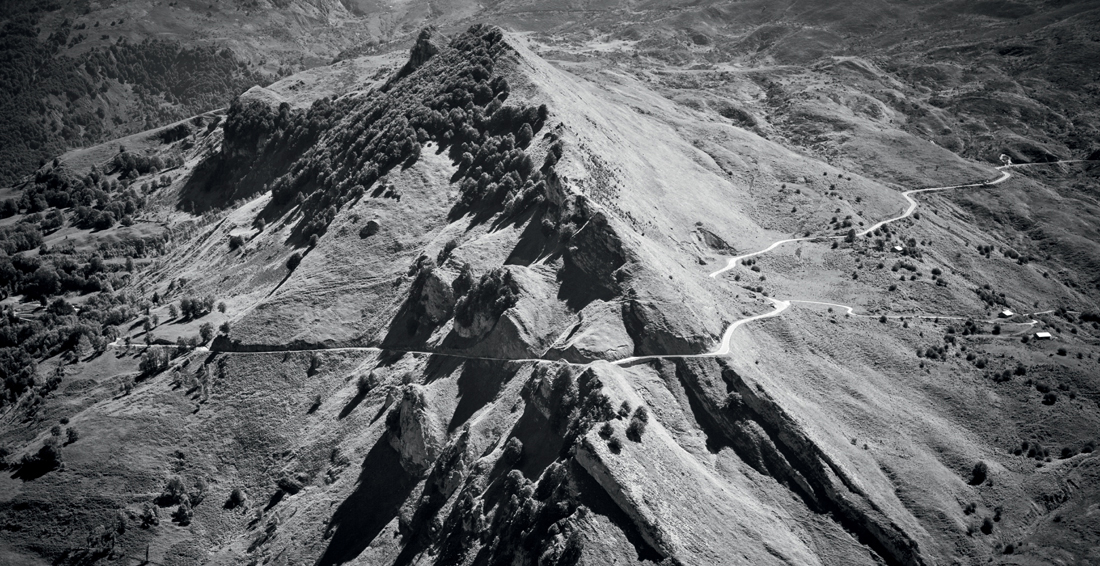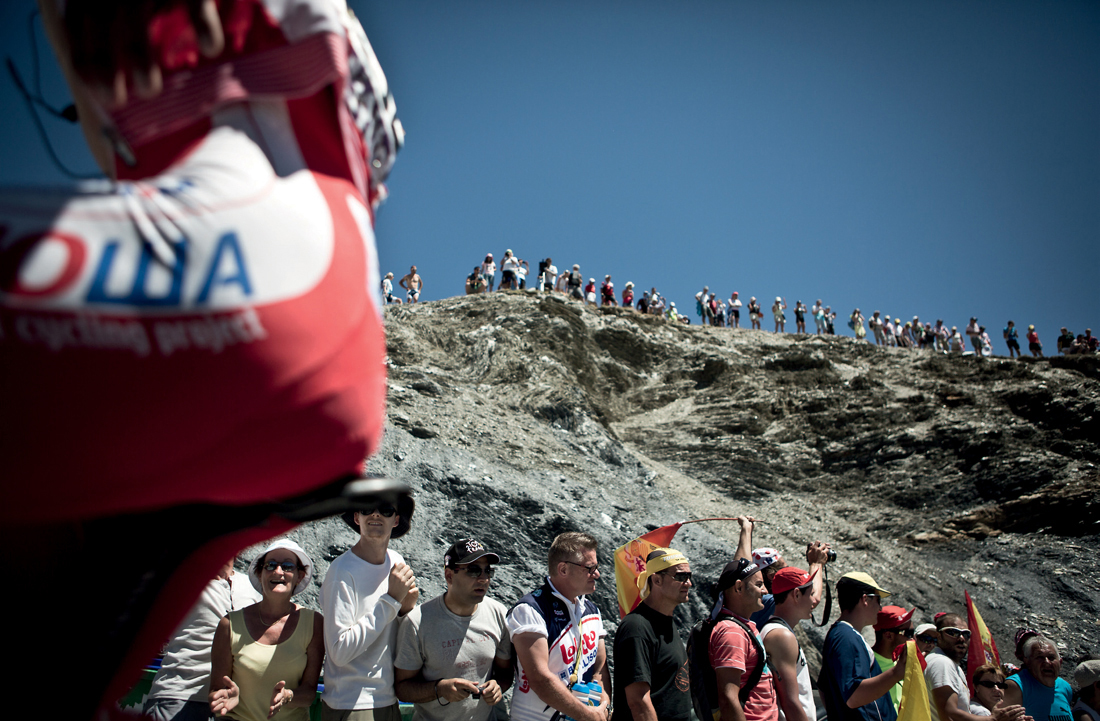
The big one. On this day the riders faced probably the most daunting stage of the Tour, with 4,686 metres of tough climbing in the High Pyrenees under a baking sun. The route followed a classic line of climbs that have been used by the Tour, from east to west or from west to east, several times since 1910. Four big mountains stood to play a potentially decisive role in deciding the overall winner: two hors catégorie climbs in the ferociously steep Col d’Aubisque and the mighty Col du Tourmalet – the most climbed mountain in the history of the Tour – followed by the Col d’Aspin with its steep, technical descent and the scary, jagged peak of Col de Peyresourde.
The bleak mountainscape, beautiful against the blue sky, had become for the day a well-populated place of pilgrimage for fans who came to line the narrow twisting roads to support the riders on their Herculean day’s task. In contrast to the families who picnic in ditches in the more bucolic stretches of the flatlands, these were diehard followers who themselves had cycled up to a good vantage point or encamped days earlier in caravans, having claimed a location with a sweeping perspective. Day trippers lined roads and ridges in scenes reminiscent of a Western, where the cowboys look up to see they are surrounded by Indians who have suddenly popped up in battle formation along the top of a hillside.
The battle here was Team Sky against Cadel Evans, but more potently Vincenzo Nibali. The pace was blistering and Evans dropped almost five minutes to the yellow jersey after being distanced on the final two climbs. Nibali had bided his time, but on the approach to Peyresourde suddenly accelerated, only to be efficiently stamped out by Wiggins and Froome working as a duo. The Italian attacked one more time, but Wiggins swiftly negated the threat. ‘The team were brilliant from the off and we knew what we had to do. It was just a case of doing what we’ve been doing since the start of this race, which is riding together as a team,’ he said. ‘It was another tough one, and obviously there weren’t many bodies left at the end. It’s good to get that one out of the way.
‘This is what we’ve trained for and that scenario is what we’ve prepared for. We’ve trained for the demands of this race and for the demands of what this race consists of in the third week. I think that’s what makes us the best riders in this race. All year it’s been about this, and training in this kind of heat and for these climbs. The fitness and recovery has been a team effort. The backroom staff’s work – with the hydration when the stages finish, and all those little things – adds up over the three weeks.’
Those little things largely come under the remit of Tim Kerrison, who has three areas of responsibility on the Tour. As head of performance support he manages the team – comprising medical, physio, nutrition, sport science, performance analysis and so on – and coordinates the delivery of support services in training and at races. As a member of the coaching team, he works with the other coaches – Rod Ellingworth, Bobby Julich and Kurt Asle Aversen – to prepare the riders for competition. And as a member of the management team – working with Dave Brailsford, Carsten Jeppesen, Rod Ellingworth and Fran Millar – he helps manage the team’s operations.
In the big picture, Kerrison coordinates the preparation of the Tour de France squad throughout the 2012 season cycle. ‘This involved bringing the core group of riders together for a series of races and training camps throughout the year,’ he explains. ‘Through this process, the riders refined their riding style as a team during the races, then went into intense training camps in between the races to further develop their physical capabilities, targeting areas where individual riders’ abilities fell short of the anticipated demands of the upcoming races.’
At the race, his presence serves several purposes. ‘First, to oversee the support services provided to the riders, including nutrition, hydration, heat management, recovery and data analysis,’ he continues. ‘Second, to work with the sport directors to align race strategy with the physical capabilities or limitations of the riders. Third, to continue to learn about the demands of the event to feed back into our preparations for future tours.’ Also known as ‘the numbers man’, Kerrison measures the riders’ individual performances using the SRM system, which records speed, distance, cadence, power, heart rate, and altitude. ‘The data is used heavily in the coaching process to analyse the demands of the events and assess riders’ performances in training and racing. The system also provides the riders with real-time feedback during racing and training, which the riders use to better pace themselves through efforts.’
This was the first of a double-header in the Pyrenees. Although the next stage didn’t look as demanding – it would be shorter, significantly – there would be a lot of tired bodies out there. As Wiggins said, ‘It’s a case of people recovering and a case of who recovers best at this stage. The one thing I keep saying is that no one has it easy out there. We’re all in the same boat. We all have to do the same course. And tomorrow is another day.’





